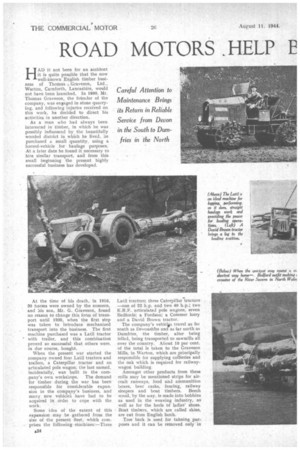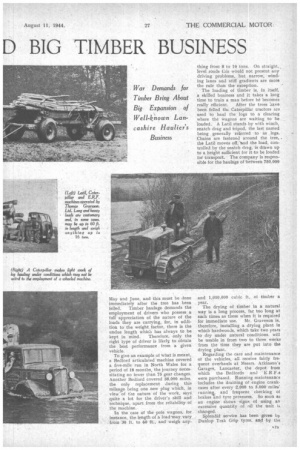ROAD MOTORS HELP E D BIG TIMBER BUSINESS
Page 26

Page 27

Page 28

If you've noticed an error in this article please click here to report it so we can fix it.
HAD it not been for an accident it is quite possible that the now well-known English limber business of Thomas ,Graveson, Ltd., Warton, Carnforth, Lancashire, would not have been launched. In 1890, Mr. Thomas Graveson, the founder of the company, was engaged in stone quarrying, and following injuries received on this work, he decided to direct his activities in another direction.
As a man who had always been interested in timber, in which he was possibly influenced by the beautifully wooded district in which he lived, he purchased a small quantity, using a horsed-vehicle for haulage purposes. -At a later date he found it necessary to hire similar transport. and from this small beginning the present highly successful business has developed.
At the time of his death, in 1916, 30 horses were owned by the concern, and his son, Mr. G. Graveson, found no reason to change this form of transport until 1930, when the first step was taken to introduce mechanized transport into the business. The first machine purchased was a Latil tractor with trailer, and this combination proved so successful that others were, in due course, bought.
When the present war started the company owned four Latil tractors and trailers, a Caterpillar tractor and an articulated pole wagon; the last named, incidentally, was built in the cornpany's own workshops. The demand for timber during the war has been responsible for considerable expansion in the company's business, and many new vehicles have had to be acquired in order to cope with the work.
Some idea of the extent of this expansion. may be gathered from the size of the present fleet, which comprises the following machines:—Three
Latil tractors; three Caterpillar tractors —one of 22 h.p. and two 40 li.p.; two E.R.F. articulated pole wagons, seven Bedfords; a Fordson; a Commer lorry and a David Brown tractor.
The company's vehicles travel as far south as Devonshlre and as far north as Dumfries, the timber, after being felled, being transported to sawmills all over the country. About 10 per cent. of the total is taken to the Graveson Mills, in Warton, which are .principally responsible for supplying collieries and the oak which is required for railway. wagon building.
Amongst other products from these mills may be mentioned strips for aircraft runways, food and ammunition boxes, beer casks, fencing, railway sleepers and boat timbers. Beech wood, by the way, is made into bobbins as used in the weaving industry, as well as for the heels of ladies' shoes. Boat timbers, which are called skins, are cut from English larch.
Tree bark is used for tahning purposes and it can be removed only in May and June, and this must be done immediately after the tree has been felled. Timber haulage demands the employment of drivers who possess a full appreciation of the nature of the loads they are carrying, for, in addition to the weight factor, there is the undue length whic'a has always to be kept in mind. Therefore, only the right type of driver is likely to obtain the best performance from a given vehicle.
To give an example of what is meant, a Bedford articulated machine covered a five-mile run in North Wales for a period of 18 months, the journey necessitating no fewer than 75 gear changes. Another Bedford covered 38,000 miles, the only replacement during this mileage being one new plug which, in view 'of tie nature of the work, says quite a lot for the driver's skill and technique, apart from the reliability of the machine.
In the case of the pole wagons, for instance, the length of a load-may vary from 30 ft. to 60 ft., and weigh any. thing from 8 to 16 tons. On straight., level roads fais would not present any driving problems, but narrow, winding lanes and stiff gradients are more the rule than the exception.
The loading of timber is, in itself, a skilled business and it takes a long time to train a man before he becomes
really efficient. After the trees :lave been felled the Caterpillar tractors are used to haul the logs to a clearing where the wagons are waiting to be loaded. A Latil stands by with winch, snatch drag and tripod, the last named being generally re.Cerred to as legs. Chains are fastened around the tree, . the Latil moves off,Nrod the load, controlled by the snatch drag, is drawn up to a height sufficient for it to be loaded for transport. The company is responsible for the haulage of between 750,000
and 1,000,000 cubic El. of timber a year. The drying of timber in a natural way is a long process, far too tong at such times as these when it is required for immediate use. Mr. Graveson is, therefore, installing a drying plant in which hardwoods, which take two years to dry undet natural conditions, will be usable in from two to three weeks from the time they are put into the drying plant.
Regarding the care and maintenance of the vehicles, all receive fairly frequent overhauls at Messrs. Atkinson's Garages, Lancaster, the depot from which the Bediords and E.R.F.s were purchased. Running maintenance includes the draining of engine crankcases after every 2,000 to 3.000 miles' runnina. and frequent checking of brakes and tyre pressures. So soon as an engine shows signs of using an excessive quantity of oil the unit changed.
Splendid service has been given by Dunlop Trak Grip tyres, and by the 1,350 by 20 Goodyear equipment used on trailers, To-day the company employs about 100 men, including drivers, loaders and workers in the sawmills, the last named including some Italian prisoners of war.
Mr. Graveson attributes the growth and success of his business to the fact that he introduced mechanized transport and keeps it roadworthy.
This is borne out by the extensive mileages which are obtained from the machines at a minimum cost for replacement parts. The policy of changing engines when a unit shows lack of economy in oil consumption has proved to be sound; it is a much wiser plan to recondition an engine in the workshop, than to be continually adopting palliatives whilst the vehicle is in service.




















































